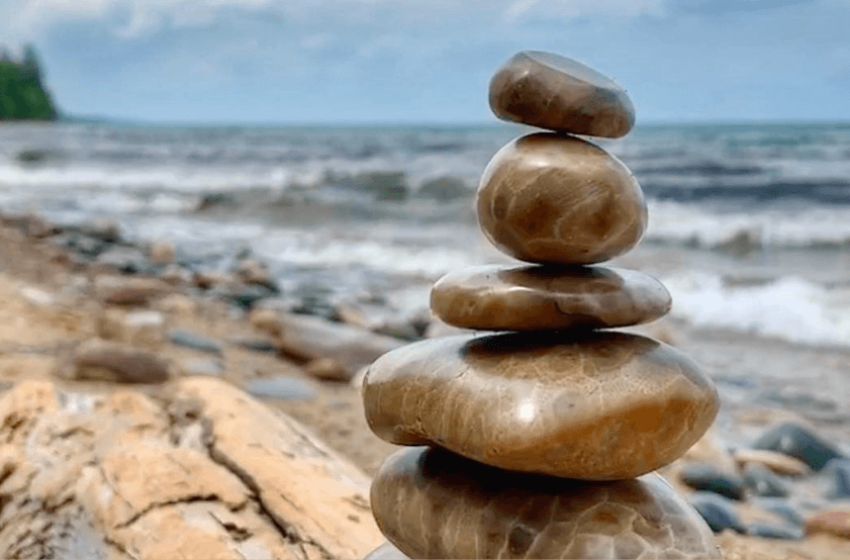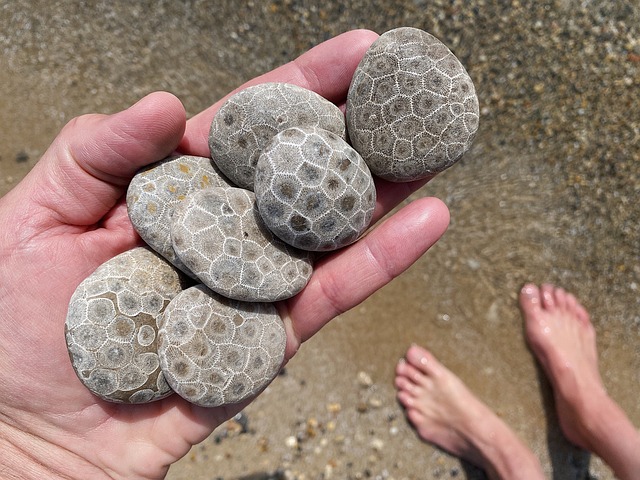A Petoskey Stone, what is it?

Petoskey Stones. You might stumble upon this weird looking rock as you walk down the shores of our great lakes. Some say it looks like a cross between a pinecone and a small dinosaur egg. And while Michigan’s state stone is certainly not a dinosaur egg, it’s actually pretty close… it is a fossil!
Read on if you’d like to learn more about what exactly a Petoskey stone is…
A long, long time ago.
Over 350 million years ago, Michigan was a tropical paradise. Its location on earth was near the equator. Although, I’m over selling the vacation getaway as Michigan was basically all underwater. Michigan at that time being a warm shallow sea was home to all sorts of marine life. And coral reef was abundant.
Like all life on the planet there is a cycle of birth and death. For Coral, this cycle is much longer than our own. Corals that are still on the planet today have a life span of upwards of 5000 years. The type of coral that created the Petoskey stone is a type of coral that equatorial Michigan had plenty of, called Rugosa.
Like the coral today, these Rugosa also had a long life and also formed colonies that could spread for miles. These Rugosa corals had a skeleton that is made up of Calcite (a type of calcium carbonate) which is why this coral is so easily fossilized when they die.
What’s fascinating about the Rugosa corals is that scientists believe that they possessed stinging cells and tentacles to help them catch prey. In other words, your Petoskey Stone was carnivorous! Imagine getting eaten by your state rock. Well, that’s awkward.
A long time ago, but more recently.
Beginning at a time when Michigan was no longer located at the equator and was in a position much more similar to where we are located today, the Pleistocene era began. This was around 2.6 million years ago. By this time the Rugosa corals had been extinct for over 250 million years and laid beneath the soils of Michigan.
Slowly the earth began to cool down, and Michigan was much more unbearable than the last week of January. Glaciers started to advance from the north and south poles toward the equator. In North America, glaciers moved as far south at the 37th parallel, and for context, that’s roughly the border of Kentucky and Tennessee. By this time all of Michigan was well under a thick and slowly moving sheet of ice.
Scientist have determined that the Pleistocene era ended recently, only 12,000 years ago. During this time, the Glaciers ripped and torn apart the surface of Michigan. These forces exposed some of Michigan’s bedrock, uncovering the buried remains of Rugosa corals. This extreme erosion, bringing to the surface what we now call Petoskey stones. (Of course, this is also how the Great Lakes basin was formed too).
Why are they called Petoskey Stones?
Petoskey, Michigan is a city located in the north-western tip of the lower peninsula. To no surprise the bulk share of Petoskey stones can be found there, although Petoskey stones can be found statewide. It’s reasonable to infer that the stone was named after the location of where you can find most of them here in Michigan.
The name Petoskey has an interesting backstory too. Here are some fun facts;
The name Petoskey comes from the Chief of the Ottawa tribe, Chief Petosega.
The name Petosega means “rising sun” “rays of dawn” or “sunbeams of promise”.
In 1965, Chief Petosega’s granddaughter, Ella Jane Petoskey was asked by Michigan Governor Romney to be the honored signatory on the bill assigning the Petoskey stone as Michigan’s state stone. And so, it was.

To find Petoskey Stones, keep your eyes on the ground.
The best places to look for these stones are on the beach. Water and sand erosion have polished these beautiful fossils into smooth gems. So, when looking, you’ll notice Petoskey Stones as they won’t look like anything else around.
Remember you don’t have to be in Petoskey, Michigan to find them. They are all over the state of Michigan and have even been found in the backyards of Royal Oak, Michigan. If you’re not near the beach, these stones might look like any other stone. These are often buried in dirt, covered in mud, dry and dusty. You might not know you collected a Petoskey stone until you clean off the dirt. Once you do, you’ll reveal a beautiful pattern unlike any other rock you’ve seen before.
Of course if you don’t want to spend the time and effort looking, you can always buy them. But what fun is that?
Have you found a Petoskey stone here in Michigan? Share this article on social media and comment letting us know where you have found a Petoskey stone, we’d love to know!
Thanks for reading and hopefully you’ve learned something today! If you want to read more, check out the artilces below or visit our homepage here.
The title image was provided to us by Michigan Photographer @_sovereign_photography_



